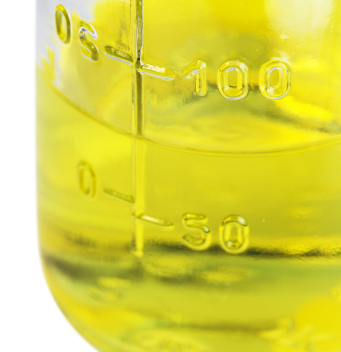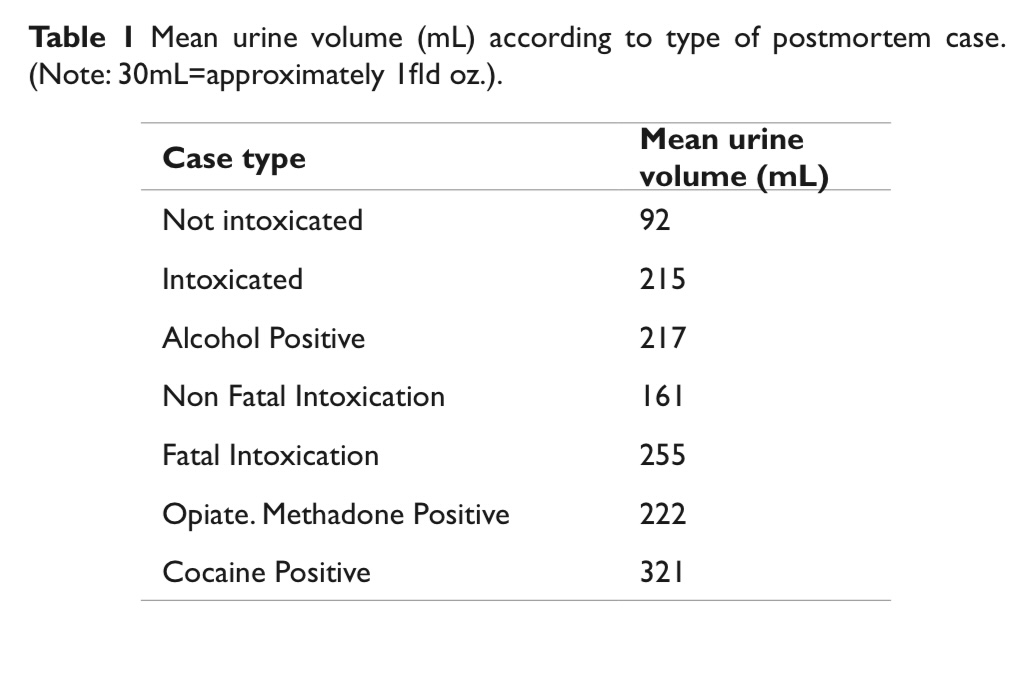Postmortem Bladder Urine Volume | Research Update

“And now for something completely different.”
Is postmortem bladder urine volume an indication of alcohol/drug intoxication? A reasonable question given that alcohol is a well-known diuretic (i.e. increases urine formation by the kidneys) as anyone can attest to if you’ve ever sat near the restrooms in a bar! The average production of urine is approximately 0.55 to 1.25 mL/min but during the consumption of alcohol it can increase nearly 10X to between 7-12 mL/min.
Generally the desire to void occurs when 150 mL of urine is in the bladder and pronounced discomfort usually occurs at a urine volume of 450 mL (WOA40401). Interestingly, the diuretic effect of alcohol decreases after drinking ends and within 2 hours after it ceases, the production of urine returns to normal even though the BAC may still be high (WOA40402).
Bladder Rupture after Minor Trauma
One adverse consequence of the diuretic and impairing effects of alcohol is that there is an increased risk of a painful bladder rupture after minor trauma (e.g. ground level fall, punch to abdomen). One study found that:
“Alcohol intoxication increases the risk of bladder rupture by several means. Intoxication decreases the sensation of, and the behavioural response to bladder filling. Both the sheer volume of alcohol and its diuretic effect increases bladder filling, often to the point of massive overdistensions. This overdistension may lead to an atonic decompensated bladder so stretched and thinned that even minor trauma may cause it to rupture.” (WOA40109)
It was originally thought that this type of alcohol-related bladder rupture occurred only in men but another recent study (WOA402U1) reported three women who attended hospital who developed lower abdominal pain after binge drinking. It was later determined that they all had suffered idiopathic rupture of the bladder.
Postmortem Bladder Urine Volume as an Indicator of Alcohol/Drug Intoxication
Traditionally, urinary bladder distension at autopsy has been regarded as a sign of intoxication of the deceased, but little scientific studies have been conducted in this area. A recent study, however, has given scientific proof of this observation. The study and citation are:
Rohner, C., S. Franckenberg, N. Schwendener, A. Oesterich, T. Kraemer, M.J. Thali, G.M. Hatch and T.D. Ruder., “New Evidence for Old Lore – Urinary Bladder Distension on Post-Mortem Computed Tomography is Related to Intoxication”, Forensic Science International, 225: 48-52, 2013 [1 table, 5 figures, 17 references]
The bladder urine volume, determined physically at autopsy by the pathologist, was compared with the urine volume calculated by computed tomography (CT) in 259 autopsy cases. Autopsy and toxicology reports in these cases were evaluated to determine if there was any correlation between urine volume at autopsy and alcohol/drug intoxication of the deceased.
The mean difference between measured urine volume and CT computed urine volume was only 0.8 mL and the correlation was good (r=0.92). The mean volume of urine increased with alcohol/drug intoxication, and the mean urine volume was greater in cases in which a fatal alcohol/drug intoxication occurred (see table).

The study found that if there was a urinary bladder volume cutoff of 182 mL, that there was a 40% sensitivity and 87% specificity of detecting alcohol/drug intoxication. If a higher cutoff urine volume of 330 mL was used, the sensitivity of detecting drug/alcohol intoxication decreased to 25% but specificity increased to 97%.
The authors concluded:
“We have found that CT provides a reliable method to quantify urinary bladder volume. In our population, there was a statistically significant correlation between urinary bladder distension on the post-mortem CT and cases of intoxication. This means that the occurrence of urinary bladder distension as single finding on post-mortem imaging should raise suspicion of intoxication and result in subsequent toxicological analysis.”
Conclusion
This recent study has shown that the old lore of postmortem urinary bladder distension and alcohol/drug intoxication in the deceased was correct. Postmortem bladder urine volume may provide a preliminary screening for the busy pathologist, coroner, medicolegal examiner and forensic toxicology labs. It also may detect cases in which there was no suspicion of alcohol /drug intoxication. Of course more research into this area is required, and toxicological findings should not be based on urine volume alone.
This study may be obtained at www.sciencedirect.com.